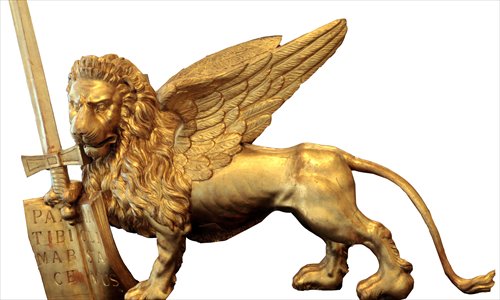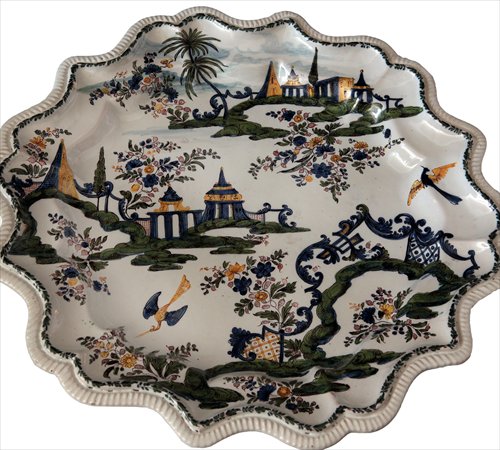

Winged Lion from the Correr Museum

Round plate with lobed border and pagoda decoration from the Ca' Rezzonico
When Marco Polo, the traveler from Venice, returned from China in the 13th century and introduced his experiences in his book The Travels of Marco Polo, a strong bond began to form between China and Italy. But just how much are these two nations connected? A couple clues to this deep relationship can be found within the antiques and art works stemming from the long period since that time.
In the exhibition Splendor of Venice - From the Renaissance to the Golden Age, 100 antiques representing the cultural, artistic and economic development of this watery city are on display at The Museum of Chinese Gardens and Landscape Architecture in Beijing.
These antiques are on loan from six leading museums in Venice, the Correr Museum, the Ca' Rezzonico, The Murano Glass Museum, Mocenigo Palace and the Carlo Goldoni's House Museum.
From oil paintings on canvas, painted potteries, bronzes and 16th century sculptures to glassware and 18th century silk embroidered dresses, every item shows the profound culture of Venice.
Mutual influence
"Marco Polo was a messenger of European culture to China. Venice itself was also very inclusive when facing the diverse culture," said Davide Giglio, the representative for the Italian embassy in China. "Till now, museums are still the main way for people to get close to the Orient in Italy, and Venice is a key gate for Asian people to get to know Italy."
The exhibition explains the history of Venice in five chapters, covering everything from the politics of ancient empires to the society and unique lifestyles of the local people.
Chinese visitors may notice some familiar sites when appreciating these Italian antiques.
A white Chinese-style vase with a blue and golden pattern is one of them. While it looks a lot like porcelain from China, it is in fact a white glass vase from the 18th century - a representative of the type of art work that was trying to imitate the fine china that was spreading to Western countries at the time.
Through a unique method, glass was fired to an opaque color and then painted with a blue pattern to make it look like a typical Chinese blue and white porcelain vase.
"Venice was opening-up and art works from that time were affected by many countries. Chinese culture was quite modern and popular at the time. Many artists saw Chinese porcelain and added these elements to their works. Oriental arts were influenced by Western art as well," said Adrea Bellieni, the main curator of the exhibition and also the director of the Correr Museum.
First established in 2010, The Museum of Chinese Gardens and Landscape Architecture is the first State-level museum that specifically focuses on presenting the art of gardens and landscapes. The museum successfully hosted the China International Garden Expo in 2013. However, this is the first time that this young museum has cooperated with international museums that focus on antiques.
"Considering the theme of The Museum of Chinese Gardens, we took time to especially highlight elements of garden and landscapes when selecting antiques and planning the entire exhibition. We hope visitors can experience the glamour of Italian culture as well as enjoy the atmosphere of a Chinese garden," said Yao An, a deputy director of Art Exhibition China and the individual in charge of arranging all the antiques.
Expressionism paintings impress at art museum
2014-08-08Sino-French group art exhibition debuts in Beijing
2014-08-06Copyright ©1999-2018
Chinanews.com. All rights reserved.
Reproduction in whole or in part without permission is prohibited.